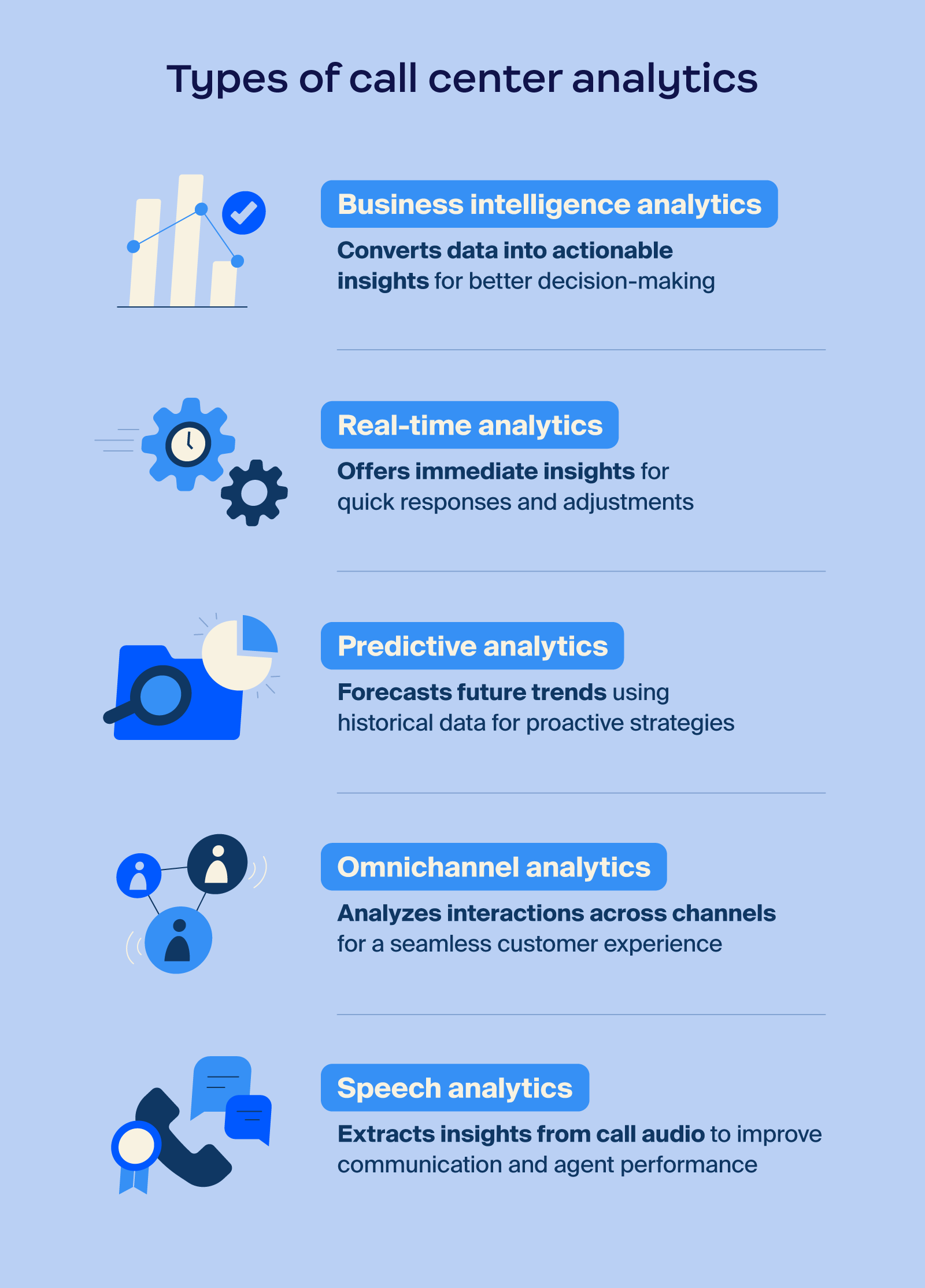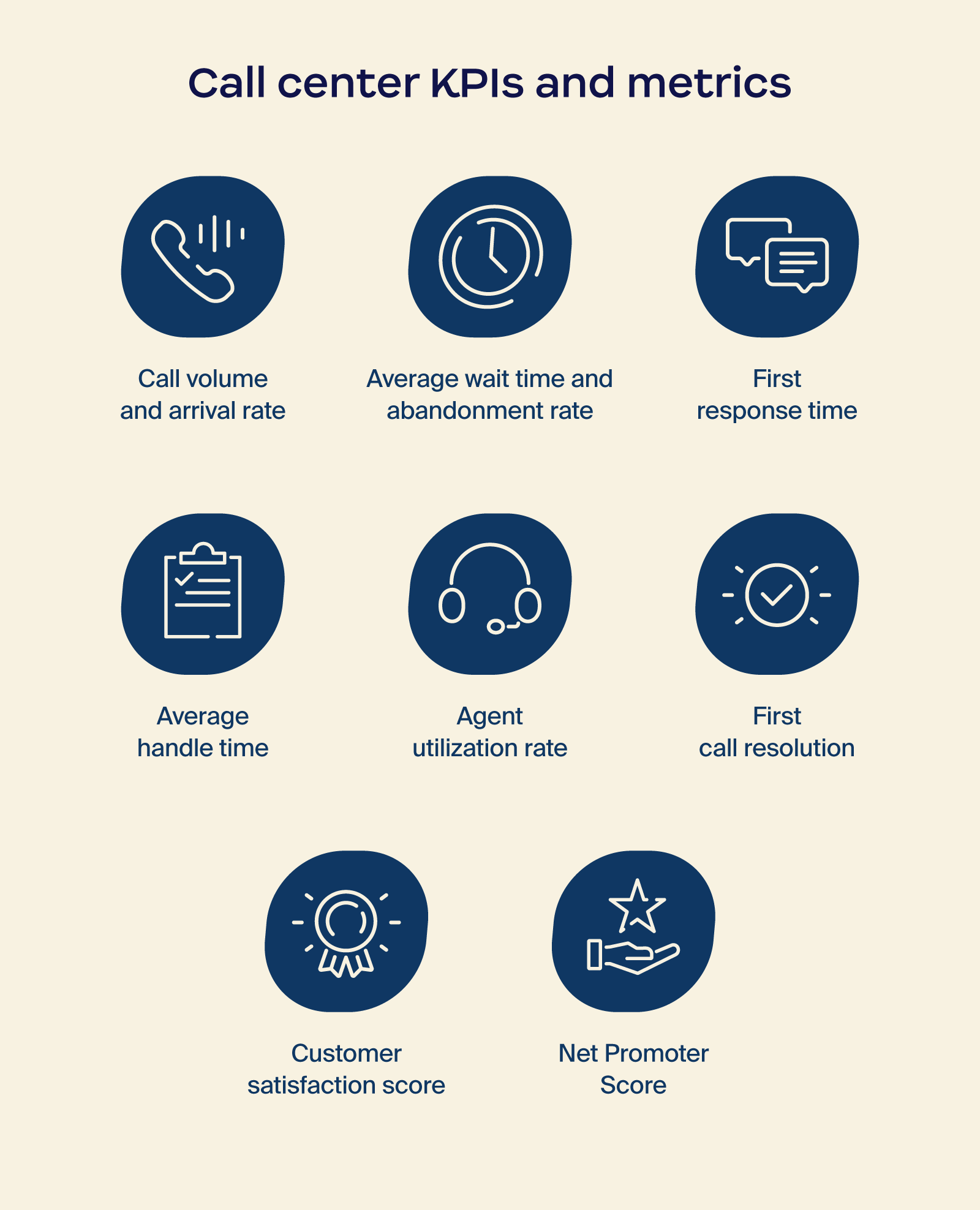
Meet Zoom AI Companion, your new AI assistant!
Boost productivity and team collaboration with Zoom AI Companion, available at no additional cost with eligible paid Zoom plans.
Updated on February 04, 2025
Published on February 04, 2025


Ever wonder what really goes on behind the scenes of a top-performing contact center?
It’s all about the numbers — more specifically, call center analytics. From tracking how long customers wait on hold to measuring the quality of each interaction, call center analytics give you a detailed look at what’s working, what’s not, and where your customer service can improve. These insights are more than just data; they’re your secret weapon to boosting efficiency, enhancing customer satisfaction, and driving better business outcomes.
In this guide, we’ll break down everything you need to know about call center analytics: the different types, why they’re essential, and which key metrics you should be focusing on.
Whether you’re aiming to streamline operations, elevate your customer experience, or simply make smarter business decisions, understanding call center analytics is your first step toward transforming your contact center into a performance powerhouse.
Contact center analytics uses data to understand what’s really happening in your contact center. It collects information from every customer interaction via various communication channels — whether it’s a phone call, chat, email, or social media — and turns that data into insights.
These insights are gathered using tools such as activity usage reports and queue analytics to show you how well agents are performing, how quickly issues are being resolved, and what your customers are really feeling. The recent innovations in AI have the potential to generate deeper insights faster and more effectively than ever before.
For instance, contact center analytics can reveal why customers are calling, highlight common pain points, and indicate where agents might need a little extra support or training.
Call center analytics come in various forms, with each offering unique insights into different aspects of your contact center’s performance. Here are five key types of call center analytics that can help you understand everything from customer behavior to agent efficiency.

Business intelligence analytics, also known as historical analytics, focuses on reviewing past call data to find trends and patterns that can shape future decisions.
It’s essentially a look back at what’s happened in your contact center, helping you understand customer behavior, agent performance, and overall efficiency. By analyzing this data, you can gain insights into what’s working well, where there are recurring issues, and how you can improve your operations.
Tracking historical analytics is key because it allows you to make informed decisions that boost performance and customer satisfaction. With a clear view of past interactions, you can fine-tune staffing, adjust training programs, and refine processes to better meet your contact center’s needs.
Examples of business intelligence analytics:
Pro Tip: Use historical data to create a “top 3 action plan” after each review. Identify the three biggest patterns or issues from your past call data and set specific actions to address them — like adjusting staffing during peak times or refining scripts for common issues. This focused approach turns insights into immediate improvements.
Real-time analytics gives you instant insights into ongoing customer interactions. For example, AI-first Zoom Workforce Management allows you to monitor activity in real-time — like queue status, agent performance, active calls, duration, and average hold times — allowing you to respond quickly to any issues. This visibility helps your team deliver top-notch service at all times.
If an agent is facing a tough call, you can jump in to assist. Or, if call volume spikes, you can adjust staffing immediately to keep wait times low. This proactive approach keeps your service running smoothly and your workforce streamlined.
Examples of real-time analytics:
Pro Tip: Set up real-time alerts for spikes in call volume. If wait times exceed a set threshold, immediately shift available agents from lower-priority tasks, like after-call work or email support, to handle incoming calls and keep queues under control.
Predictive analytics involves analyzing historical data to forecast future trends, helping you optimize your contact center operations. By examining past customer interactions and behaviors, this type of analytics allows you to anticipate customer needs and handle them more efficiently. Think of it as having a crystal ball that helps you prepare for what’s ahead, so your team is ready to tackle any challenge.
Tracking predictive analytics is crucial because it enables proactive decisions. For example, if you spot a trend indicating an increase in customer inquiries about a specific product, you can prepare your agents with the right information and resources in advance. This foresight not only boosts efficiency but also enhances the customer experience, as you’re able to address their issues before they even have to ask.
Examples of predictive analytics:
Pro Tip: Leverage predictive analytics to forecast peak call times and schedule your top-performing agents during these periods. This puts the right skills in place when demand is highest, reducing call handling time and boosting customer satisfaction.
Omnichannel analytics tracks customer interactions across multiple channels — phone, email, chat, social media — and brings them together in one view. Instead of looking at each channel separately, this approach helps you see the full customer journey and understand how they navigate between channels. Tracking these analytics is crucial because it shows you what’s working, what’s not, and how you can improve the overall experience.
Examples of omnichannel analytics:
Pro Tip: Regularly review your omnichannel analytics to identify the most popular customer channels and optimize them first. For instance, if chat support sees the highest traffic but has slower response times, consider reallocating resources or training specific chat agents to boost efficiency and customer satisfaction on that channel.
Speech analytics is a tool that analyzes the audio content of calls to uncover insights about customer sentiment, agent behavior, and call outcomes. It examines keywords, tone, and speech patterns to understand not just what’s being said but how it’s being conveyed. Tracking speech analytics helps you identify common customer complaints, monitor compliance, and find opportunities to refine the customer experience and improve agent performance.
Examples of speech analytics:
Pro Tip: Set up your speech analytics tool to flag calls with disgruntled customers in real-time. Use these alerts to prioritize immediate follow-up by a supervisor or a senior agent, allowing you to address customer concerns before they escalate further.
Tracking call center metrics is essential for any business looking to improve contact center performance and deliver exceptional customer service. By leveraging analytics, you can gain a deeper understanding of customer interactions, optimize your operations, and make smarter, data-driven decisions that drive results.

Measuring the right key performance indicators (KPIs) and metrics is essential for understanding your contact center’s performance and identifying areas for improvement. These metrics give you a detailed view of how well your team handles customer interactions, manages call volume, and maintains efficiency. Here’s a closer look at key KPIs every contact center should track.
To effectively track performance, measuring contact center analytics is key. By using various tools and methods, you can collect data on agent efficiency, customer interactions, and overall service quality. Here’s how to leverage these analytics to gain actionable insights and optimize your contact center’s performance.
To start measuring performance, zero in on the KPIs that matter most to your contact center. Think about your business goals, what your customers expect, and industry benchmarks.
For example, if your focus is on boosting customer satisfaction, prioritize metrics like first-call resolution and CSAT. If efficiency is your main goal, keep an eye on average handle time and agent utilization rate. The right KPIs will give you actionable insights into what’s working and what’s not.
Using a balanced scorecard approach can help you track KPIs from multiple angles: financial (cost per call), customer satisfaction (NPS, CES), internal processes (average wait time), and growth (agent training effectiveness). This way, you’re not just measuring numbers — you’re getting a full view of your contact center’s performance and spotting areas where you can improve.
Selecting the right software is crucial for aligning with your KPIs and turning data into actionable insights. Zoom Contact Center offers comprehensive AI-first tools like real-time analytics, automated reporting, and predictive insights that help you stay ahead of trends and improve performance. With Zoom Contact Center, you can capture key metrics, enhance decision-making, and streamline operations more effectively than other platforms.
Set up customizable dashboards to visualize your data clearly. Our intuitive dashboards can be tailored for different stakeholders, from managers tracking agent productivity to executives monitoring customer satisfaction. This helps everyone stay aligned and can easily identify areas for improvement, driving better outcomes across your organization.
Set up a robust data collection system that captures all relevant information, such as call recordings, agent performance metrics, and customer feedback. Use AI to gather data consistently and efficiently across all channels so nothing slips through the cracks. Implement checks to validate data quality and avoid errors that could skew your analysis.
After collecting data, leverage analytics tools to drill down into specifics — like identifying the top reasons for call escalations or tracking patterns in customer complaints. Use these insights to pinpoint actionable improvements, such as refining scripts or adjusting agent training. Regularly audit your data accuracy to make decisions that are always based on reliable information, allowing you to address issues quickly and effectively.
Establishing benchmarks for your KPIs is essential for measuring your contact center’s performance against both industry standards and your own internal goals. Start by researching industry averages for key metrics like average handle time and FCR to set realistic targets. This gives you a clear framework to assess how well your team is performing and highlights areas that may need attention.
Once benchmarks are in place, track your progress regularly to identify trends and areas for improvement. Use your analytics tools to monitor performance over time and compare it against your established benchmarks.
This ongoing analysis allows you to make informed decisions, whether it’s reallocating resources, adjusting training programs, or refining processes to optimize your call center operations. Consistent tracking helps you stay proactive in enhancing performance and delivering better customer experiences.
Contact center software solutions with AI-enabled analytics functionalities like Zoom Contact Center are essential tools that help organizations gain insights into customer interactions, agent performance, and overall operational efficiency. These solutions enable businesses to analyze data effectively, allowing for informed decision-making that enhances customer experiences and optimizes workflows. By leveraging analytics software, companies can uncover trends, identify pain points, and ultimately improve service delivery.
When evaluating contact center analytics software, consider these key components:
With Zoom Contact Center’s AI-first CX suite, businesses can engage customers more effectively, boost agent productivity, and optimize overall business outcomes. When human intervention is needed, AI helps route customers to the most qualified agent with all the relevant customer context in hand, speeding up resolutions.
On the agent side, AI streamlines workflows and provides access to actionable insights, empowering agents to deliver better service. With real-time performance tracking, businesses can continuously improve operations, empower agents, and create a loyal customer base.
To effectively streamline your contact center data collection and reporting, leveraging a comprehensive solution like Zoom Contact Center can make a significant difference.
With its robust analytics capabilities, you can easily gather insights across channels, so you get a complete picture of customer interactions and agent performance. This not only helps you make informed decisions but also enhances the overall efficiency of your operations.
With the right tools in place, you can transform your data into actionable insights and drive continuous improvement in your contact center. Start optimizing your data collection and reporting with Zoom Contact Center today.
Still have questions about contact center analytics? We answer them below so you can better understand how to leverage data for improved performance.
A contact center analyst evaluates data related to customer interactions and agent performance to enhance operational efficiency. They identify trends, recommend improvements, and provide insights that help management make informed decisions to boost customer satisfaction and performance.
Analyzing data in a call center involves collecting information from sources like call recordings and customer feedback. Analysts use software to organize this data, calculate KPIs, and identify patterns. This process helps extract actionable insights that inform strategies for improving customer experience and agent performance.
To improve call center operations, start by reviewing performance metrics to pinpoint areas for improvement. Invest in advanced analytics tools to gain deeper insights and provide training to enhance agent skills. Streamline processes and automate repetitive tasks to boost efficiency. Regularly adjust your strategies based on data insights for continuous improvement.